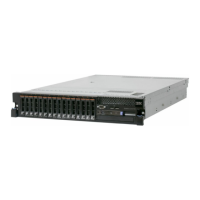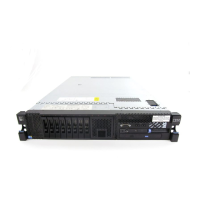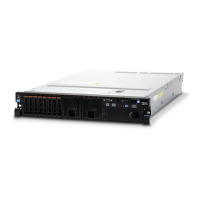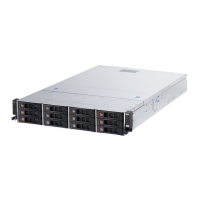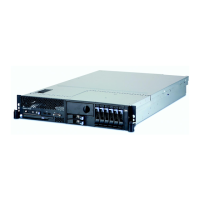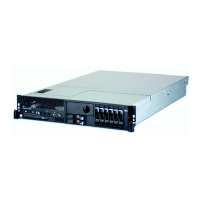Solving power problems
Power problems can be difficult to solve. For example, a short circuit can exist
anywhere on any of the power distribution buses. Usually, a short circuit will cause
the power subsystem to shut down because of an overcurrent condition. To
diagnose a power problem, use the following general procedure:
1. Turn off the server and disconnect all power cords.
2. Check for loose cables in the power subsystem. Also check for short circuits, for
example, if a loose screw is causing a short circuit on a circuit board.
3. Check the LEDs on the operator information panel (see “Light path diagnostics
LEDs” on page 65).
4. If a power-channel error LED on the system board is lit, complete the following
steps; otherwise, go to step 5. See “System-board LEDs” on page 20 for the
location of the power-channel error LEDs. Table 11 identifies the components
that are associated with each power channel and the order in which to
troubleshoot the components.
a. Disconnect the cables and power cords to all internal and external devices
(see “Internal cable routing and connectors” on page 172). Leave the
power-supply cords connected.
b. Remove each component that is associated with the LED, one at a time, in
the sequence indicated in Table 11, restarting the server each time, until the
cause of the overcurrent condition is identified.
Important: Only a trained service technician should remove or replace a
FRU, such as a microprocessor or the system board. See Chapter 4, “Parts
listing, Types 4255, 7945, and 7949 server,” on page 157 to determine
whether a component is a FRU.
Table 11. Components associated with power-channel error LEDs
Power-channel
error LED Components
A CD or DVD drive (optical drive), fans, hard disk drives, hard disk
drive backplanes
B PCI riser-card assembly in PCI connector 1 on the system board,
DIMMs 1 through 16, microprocessor 2
C Tape drive if one is installed, SAS riser card assembly, DIMMs 1
through 8, microprocessor 1
D Microprocessor 1, system board
E Optional PCI video graphics adapter power cable if one is
installed (connector J154 on the system board), optional PCI
video graphics adapter if one is installed, PCI riser card assembly
in PCI connector 2 on the system board, microprocessor 2
AUX Power All PCI adapters and PCI riser-card assemblies, SAS riser-card
assembly, operator information panel assembly, optional two-port
Ethernet card if installed
c. Replace the identified component.
5. Remove the adapters and disconnect the cables and power cords to all internal
and external devices until the server is at the minimum configuration that is
required for the server to start (see “Solving undetermined problems” on page
154 for the minimum configuration).
Chapter 3. Diagnostics 153
